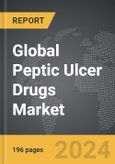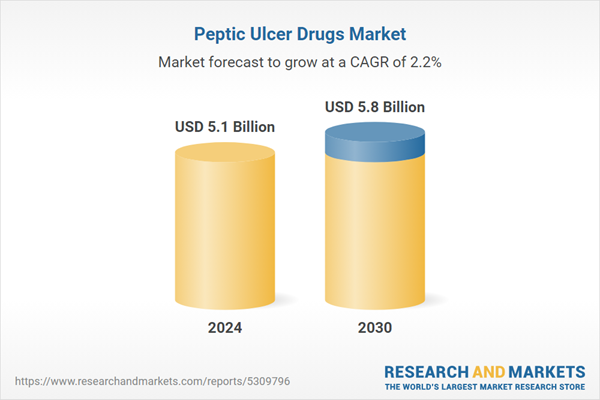The global market for Peptic Ulcer Drugs was valued at US$5.1 Billion in 2024 and is projected to reach US$5.8 Billion by 2030, growing at a CAGR of 2.2% from 2024 to 2030. This comprehensive report provides an in-depth analysis of market trends, drivers, and forecasts, helping you make informed business decisions. The report includes the most recent global tariff developments and how they impact the Peptic Ulcer Drugs market.
Segments: Segment (Antibiotics, Proton Pump Inhibitors (PPIs), H2 Antagonists, Other Segments).
Geographic Regions/Countries: World; United States; Canada; Japan; China; Europe (France; Germany; Italy; United Kingdom; and Rest of Europe); Asia-Pacific; Rest of World.
The analysts continuously track trade developments worldwide, drawing insights from leading global economists and over 200 industry and policy institutions, including think tanks, trade organizations, and national economic advisory bodies. This intelligence is integrated into forecasting models to provide timely, data-driven analysis of emerging risks and opportunities.
Global Peptic Ulcer Drugs Market - Key Trends & Drivers Summarized
How Are Technological Advances Impacting the Development of Peptic Ulcer Drugs?
The peptic ulcer drugs market has seen remarkable growth due to technological advancements in drug formulation and delivery methods. Peptic ulcers, often caused by Helicobacter pylori infections or the overuse of nonsteroidal anti-inflammatory drugs (NSAIDs), require treatments that can reduce stomach acid production and promote healing. Advances in drug research have led to the development of proton pump inhibitors (PPIs), H2 receptor antagonists, and antibiotics, which target the underlying causes of ulcers more effectively. Additionally, new drug delivery technologies, such as sustained-release formulations and nanoparticle-based therapies, are enhancing the bioavailability and efficacy of existing drugs, allowing for more targeted treatment and faster healing. Recent innovations also include combination therapies, which combine antibiotics with acid-reducing agents, offering a more comprehensive approach to eradicating H. pylori infections and preventing ulcer recurrence. These technological developments are driving better treatment outcomes and improving patient adherence to peptic ulcer therapy regimens.Why Is There an Increasing Demand for Peptic Ulcer Drugs?
The demand for peptic ulcer drugs is rising due to the increasing prevalence of gastrointestinal disorders, including peptic ulcers, driven by modern lifestyle factors such as poor diet, high stress levels, and the widespread use of NSAIDs. The global increase in H. pylori infections, which are responsible for the majority of peptic ulcers, has further fueled the need for effective drug treatments. With the aging population, gastrointestinal issues are becoming more common, especially among individuals who rely on NSAIDs for chronic pain management, increasing the demand for ulcer prevention and treatment. Additionally, the rise in awareness about gastrointestinal health, along with improved diagnostic capabilities, has led to earlier detection of peptic ulcers, contributing to a growing market for ulcer-related medications. As patients seek relief from the discomfort and potential complications of peptic ulcers, the demand for both over-the-counter (OTC) and prescription ulcer medications continues to rise.How Are Healthcare Trends and Patient Preferences Shaping the Peptic Ulcer Drugs Market?
Healthcare trends and changing patient preferences are significantly shaping the peptic ulcer drugs market, particularly in the areas of personalized medicine and self-medication. Patients are increasingly opting for personalized treatment regimens that take into account their specific health conditions, genetic predispositions, and lifestyle factors. This has led to the development of targeted therapies for peptic ulcers, especially for those caused by H. pylori infections, where tailored antibiotic treatments are becoming more common. Additionally, there is a growing trend toward self-medication for mild cases of peptic ulcers and acid reflux, with patients increasingly turning to OTC medications such as antacids, H2 blockers, and PPIs. This shift is driving the market for non-prescription drugs that provide quick relief from ulcer symptoms, while still maintaining safety and efficacy. As healthcare systems encourage patient empowerment and preventive care, demand for accessible, over-the-counter solutions is rising, complementing the ongoing need for prescription medications for more severe cases.What Factors Are Driving Growth in the Peptic Ulcer Drugs Market?
The growth in the peptic ulcer drugs market is driven by several factors, including the rising prevalence of gastrointestinal disorders, advancements in drug formulation and delivery, and changing patient behaviors. The global increase in H. pylori infections, coupled with widespread NSAID use, is a major factor contributing to the growing demand for ulcer treatments. Additionally, advancements in drug development, such as the introduction of combination therapies and sustained-release formulations, are improving treatment outcomes and driving market expansion. The aging population is also playing a critical role, as older adults are more prone to gastrointestinal issues and require long-term medication management. Furthermore, the rise of self-medication and the growing availability of over-the-counter drugs are increasing market demand, particularly for products that provide rapid symptom relief. Healthcare systems’ focus on early diagnosis and preventive care is encouraging the use of ulcer medications, contributing to the market’s sustained growth. As lifestyle factors continue to impact gastrointestinal health, the peptic ulcer drugs market is expected to see ongoing expansion, driven by these technological, healthcare, and consumer trends.Report Scope
The report analyzes the Peptic Ulcer Drugs market, presented in terms of units. The analysis covers the key segments and geographic regions outlined below.Segments: Segment (Antibiotics, Proton Pump Inhibitors (PPIs), H2 Antagonists, Other Segments).
Geographic Regions/Countries: World; United States; Canada; Japan; China; Europe (France; Germany; Italy; United Kingdom; and Rest of Europe); Asia-Pacific; Rest of World.
Key Insights:
- Market Growth: Understand the significant growth trajectory of the Antibiotics segment, which is expected to reach US$2.6 Billion by 2030 with a CAGR of a 2.0%. The Proton Pump Inhibitors (PPIs) segment is also set to grow at 3.0% CAGR over the analysis period.
- Regional Analysis: Gain insights into the U.S. market, valued at $1.4 Billion in 2024, and China, forecasted to grow at an impressive 2.0% CAGR to reach $927.2 Million by 2030. Discover growth trends in other key regions, including Japan, Canada, Germany, and the Asia-Pacific.
Why You Should Buy This Report:
- Detailed Market Analysis: Access a thorough analysis of the Global Peptic Ulcer Drugs Market, covering all major geographic regions and market segments.
- Competitive Insights: Get an overview of the competitive landscape, including the market presence of major players across different geographies.
- Future Trends and Drivers: Understand the key trends and drivers shaping the future of the Global Peptic Ulcer Drugs Market.
- Actionable Insights: Benefit from actionable insights that can help you identify new revenue opportunities and make strategic business decisions.
Key Questions Answered:
- How is the Global Peptic Ulcer Drugs Market expected to evolve by 2030?
- What are the main drivers and restraints affecting the market?
- Which market segments will grow the most over the forecast period?
- How will market shares for different regions and segments change by 2030?
- Who are the leading players in the market, and what are their prospects?
Report Features:
- Comprehensive Market Data: Independent analysis of annual sales and market forecasts in US$ Million from 2024 to 2030.
- In-Depth Regional Analysis: Detailed insights into key markets, including the U.S., China, Japan, Canada, Europe, Asia-Pacific, Latin America, Middle East, and Africa.
- Company Profiles: Coverage of players such as Abbott Laboratories, AstraZeneca PLC, Cadila Healthcare Ltd. (Zydus Cadila), Daewoong Pharmaceutical Co., Ltd., Eisai Co., Ltd. and more.
- Complimentary Updates: Receive free report updates for one year to keep you informed of the latest market developments.
Some of the 46 companies featured in this Peptic Ulcer Drugs market report include:
- Abbott Laboratories
- AstraZeneca PLC
- Cadila Healthcare Ltd. (Zydus Cadila)
- Daewoong Pharmaceutical Co., Ltd.
- Eisai Co., Ltd.
- Pharmaking Co., Ltd.
- Taiho Pharmaceutical Co., Ltd.
- Takeda Pharmaceutical Co., Ltd.
- Yuhan Corporation
Tariff Impact Analysis: Key Insights for 2025
Global tariff negotiations across 180+ countries are reshaping supply chains, costs, and competitiveness. This report reflects the latest developments as of April 2025 and incorporates forward-looking insights into the market outlook.The analysts continuously track trade developments worldwide, drawing insights from leading global economists and over 200 industry and policy institutions, including think tanks, trade organizations, and national economic advisory bodies. This intelligence is integrated into forecasting models to provide timely, data-driven analysis of emerging risks and opportunities.
What’s Included in This Edition:
- Tariff-adjusted market forecasts by region and segment
- Analysis of cost and supply chain implications by sourcing and trade exposure
- Strategic insights into geographic shifts
Buyers receive a free July 2025 update with:
- Finalized tariff impacts and new trade agreement effects
- Updated projections reflecting global sourcing and cost shifts
- Expanded country-specific coverage across the industry
Table of Contents
I. METHODOLOGYII. EXECUTIVE SUMMARY2. FOCUS ON SELECT PLAYERSIII. MARKET ANALYSISIV. COMPETITION
1. MARKET OVERVIEW
3. MARKET TRENDS & DRIVERS
4. GLOBAL MARKET PERSPECTIVE
UNITED STATES
CANADA
JAPAN
CHINA
EUROPE
FRANCE
GERMANY
ITALY
UNITED KINGDOM
REST OF EUROPE
ASIA-PACIFIC
REST OF WORLD
Companies Mentioned (Partial List)
A selection of companies mentioned in this report includes, but is not limited to:
- Abbott Laboratories
- AstraZeneca PLC
- Cadila Healthcare Ltd. (Zydus Cadila)
- Daewoong Pharmaceutical Co., Ltd.
- Eisai Co., Ltd.
- Pharmaking Co., Ltd.
- Taiho Pharmaceutical Co., Ltd.
- Takeda Pharmaceutical Co., Ltd.
- Yuhan Corporation
Table Information
| Report Attribute | Details |
|---|---|
| No. of Pages | 196 |
| Published | April 2025 |
| Forecast Period | 2024 - 2030 |
| Estimated Market Value ( USD | $ 5.1 Billion |
| Forecasted Market Value ( USD | $ 5.8 Billion |
| Compound Annual Growth Rate | 2.2% |
| Regions Covered | Global |









